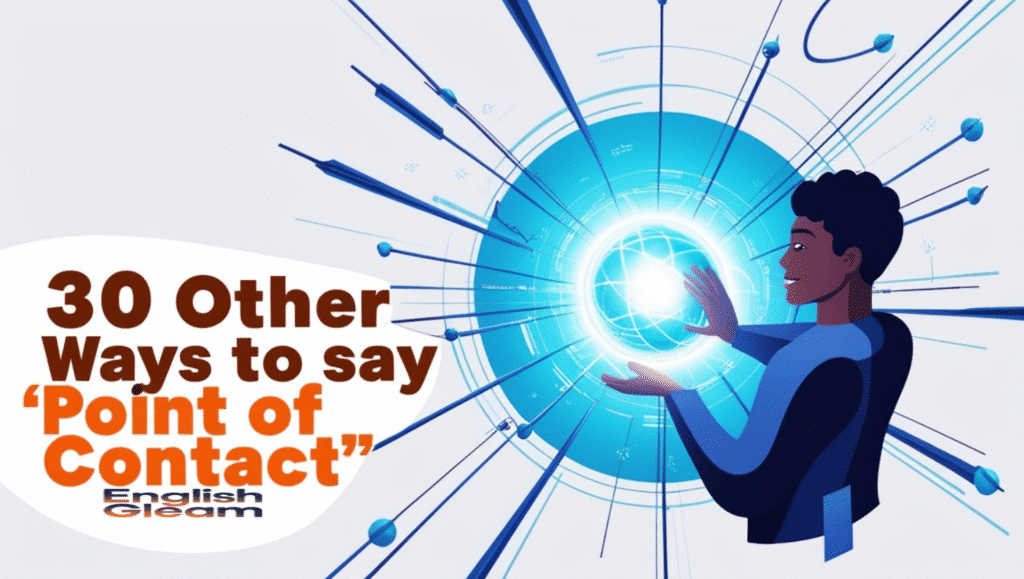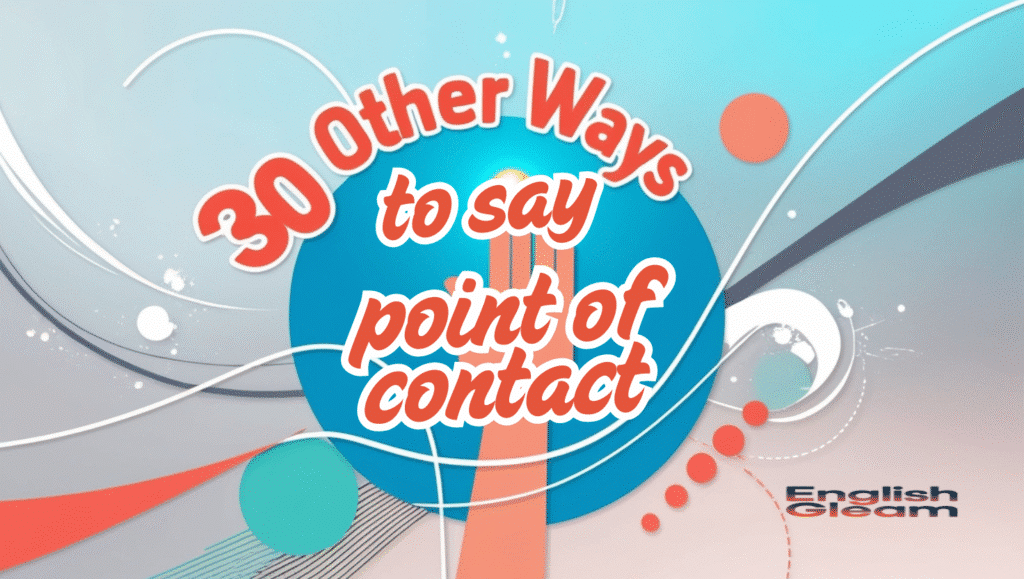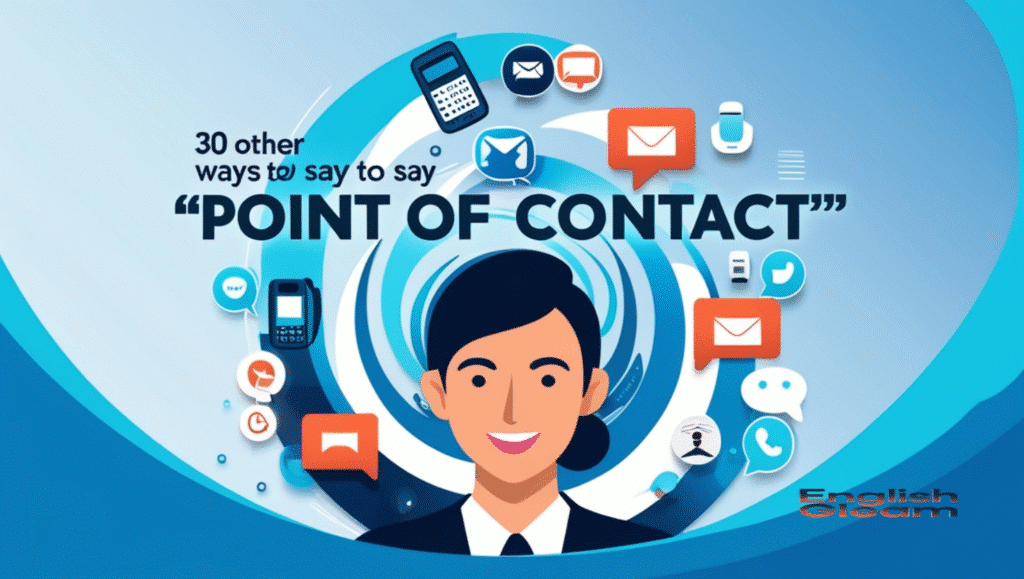A “point of contact” means the main person you talk to about something. This person shares updates, answers questions, and helps things run smoothly. It’s a common term in business and teams.
Tired of using the same phrase over and over? Want your messages to feel fresh and more personal? This list will give you 30 better ways to say it.
These other words work in emails, meetings, and reports. They sound clear, polite, and professional. You’ll find examples for each one.
What Does “Point of Contact” Actually Mean?
In the simplest terms, a point of contact (POC) is the person who handles communication for a specific matter. They’re the go-to person, the liaison, the assigned representative who takes responsibility for relaying or receiving information.
In business settings, using a term like “POC” is efficient, but it can sometimes come across as stiff or impersonal—especially in client-facing roles. That’s where variations help.
Why Use Alternatives to “Point of Contact”?
Advantages:
- Makes your writing or speech feel less mechanical
- Tailors the tone based on audience or formality
- Builds connection, especially in customer relationships
When to Use a Replacement Phrase:
- Writing client-facing emails
- Updating a website’s contact section
- Assigning roles in project documentation
Synonyms & Phrases for “Point of Contact”
Here’s a categorized list of 30 alternatives, broken down by context, tone, and formality. Each comes with an example and suggested use-case.
| Alternative Term | Best Used In | Tone | Example Use |
|---|---|---|---|
| Main Contact | Emails, websites | Neutral | “Laura is your main contact for billing support.” |
| Lead Contact | Team projects | Professional | “Please coordinate with Sam, our lead contact.” |
| Assigned Representative | Formal assignments | Formal | “John is the assigned representative for this case.” |
| Communications Lead | Public relations, media | Formal | “Lisa will be the communications lead for the event.” |
| Client Contact | Customer service | Warm/Professional | “Reach out to Eva, your client contact, for any updates.” |
| Relationship Manager | Client management | Warm/Trusted | “Meet your relationship manager, Ben Williams.” |
| Go-To Person | Informal settings | Friendly | “If you’re stuck, Jane is your go-to person.” |
| Contact Person | Forms, generic use | Neutral | “Your contact person is listed on the confirmation email.” |
| Key Contact | Projects, external partners | Formal | “He’s the key contact for this proposal.” |
| Designated Contact | Legal, corporate roles | Very Formal | “Susan is the designated contact for compliance matters.” |
Full List: 30 Alternatives to “Point of Contact”
1. Main Contact
Great for general communication. Clear and easy to understand.
“Your main contact for deliveries is Jordan Reed.”
2. Lead Contact
Suggests leadership in communications. Ideal for projects.
“Please connect with Olivia—she’s the lead contact for Phase 2.”
3. Assigned Representative
Emphasizes official delegation.
“Each client will have an assigned representative by Monday.”
4. Communications Lead
Best for media, PR, or large corporate functions.
“The communications lead will brief the press tomorrow.”
5. Client Contact
Warmer tone for client interactions.
“Your client contact is Sarah Jacobs.”
6. Relationship Manager
Adds a human touch—implies long-term relationship.
“Your relationship manager will assist you throughout the contract.”
7. Go-To Person
Casual, friendly, great for internal use.
“Need help? Kelly’s your go-to person for onboarding.”
8. Contact Person
Simple and standard.
“The contact person for this session is noted in your schedule.”
9. Key Contact
Formal and respectful.
“Greg is the key contact for procurement inquiries.”
10. Designated Contact
Formal and administrative.
“For legal matters, please refer to the designated contact.”
11. Account Manager
Widely used in sales and services.
“Talk to your account manager if you have billing concerns.”
12. Team Lead
Adds structure and clarity.
“The team lead will walk you through the project brief.”

13. Client Liaison
Implies coordination with empathy.
“Your client liaison ensures smooth collaboration.”
14. Official Contact
Stresses legitimacy and formality.
“This letter identifies our official contact for the matter.”
15. Spokesperson
Perfect for public announcements.
“Our spokesperson will make a statement this evening.”
16. Project Coordinator
Common in management circles.
“Direct all questions to the project coordinator.”
17. Engagement Manager
Adds a relationship-focused role.
“Your engagement manager will follow up this week.”
18. Primary Contact
Emphasizes priority.
“John is the primary contact for this campaign.”
19. Support Rep
Casual and customer-friendly.
“Talk to our support rep via the live chat button.”
20. Internal Guide
Creative, informal phrase for internal onboarding.
“Linda is your internal guide during orientation.”
21. Customer Rep
Casual, often used in help centers.
“A customer rep will be with you shortly.”
22. Service Manager
Used in hospitality or facilities.
“Ask for the service manager on duty.”
23. Fallback Person
When someone is the backup.
“If Sarah’s unavailable, Mark is the fallback person.”
24. Project Lead
When they’re running the whole show.
“Derek is the project lead and main decision-maker.”

25. Media Contact
Used for press or marketing teams.
“Media inquiries go through our media contact, Rachel.”
26. Account Rep
Sleek and modern. Used in tech & sales.
“Ping your account rep for demo access.”
27. Formal Liaison
Appropriate in government or law.
“This agreement names Mark as the formal liaison.”
28. Coordinator
General and widely adaptable.
“The coordinator will share next steps.”
29. Admin Contact
Used in schools, HR, or event planning.
“Your admin contact can help you with paperwork.”
30. SPOC (Single Point of Contact)
Popular in IT and corporate sectors.
“For tech issues, Mark is your SPOC.”
Real-Life Examples: When to Use What
Here’s a table showing which alternative to use based on the setting:
| Scenario | Best Alternative | Tone |
|---|---|---|
| Corporate project assignment | Designated Contact, SPOC | Formal |
| Client onboarding | Relationship Manager, Client Contact | Friendly/Professional |
| Internal team workflow | Go-To Person, Coordinator | Casual/Collaborative |
| Customer support portal | Support Rep, Customer Rep | Friendly |
| Press or media announcement | Communications Lead, Spokesperson | Authoritative |
| Legal or administrative matters | Official Contact, Formal Liaison | Very Formal |
Frequently Asked Questions (FAQs)
Q1: Is it still okay to use “point of contact”?
Absolutely. It’s widely accepted and professional. But if you’re writing a client email or website copy, an alternative may offer a more tailored tone.
Q2: Which phrase sounds the friendliest?
“Go-to person” and “relationship manager” feel more human and inviting—great for people-facing roles.
Q3: Are there formal alternatives for contracts or proposals?
Yes. Use “designated contact,” “official representative,” or “formal liaison.” These carry legal or authoritative weight.
Q4: What’s a modern or trendy term in startups?
“SPOC” (Single Point of Contact) and “account rep” are both stylish and used heavily in tech.
Final Thoughts
Using different ways to say “point of contact” can make your writing sound more friendly and clear. It also helps your message feel more personal.
Whether you’re writing an email or talking to a client, these words can make a big difference. Pick the one that fits your tone and setting best. They all keep your communication strong and professional.

William Jams is an experienced blogger at EnglishGleam, passionate about language, writing, and storytelling. With years of expertise in crafting engaging content, she aims to inspire readers through insightful articles that enhance their English skills and knowledge.







Hi [englishgleam.com],
We do things differently at Ranking Hat—you only pay when we deliver.
More traffic? More leads? More sales? We handle it all—ads, SEO, social.
Want to grow without wasting budget? Just reply “More.” Or Book a schdule – https://calendar.app.google/cVmB7TfUBqwfAPVa7
Thanks!
Nitin from Ranking Hat
Note: – If you’re not Interested in our Services, send us “NO”
i am intereted
Hello
I wanted to see if you would be open to rejuvenating your website with our complete website package.
We are giving away free websites right now, you only pay for maintenance.
Here is our offer
1. We rebuild your website
2. We maintain your website monthly with maintenance and provide you one hour every month of page updates to keep your website up to date for your business, all included.
And You Get a one-time completely free on-site SEO. Yes, no SEO subscriptions with us!
Get This Entire Package for only $97 a month! For real..
And the best part is there is no up-front fee!
We are doing this because we do not believe its fair for businesses to pay so much for a great website.
Click Here to Get Started
http://www.websolutionsgenius.com/awardwinningwebsites/
To Your Abundance